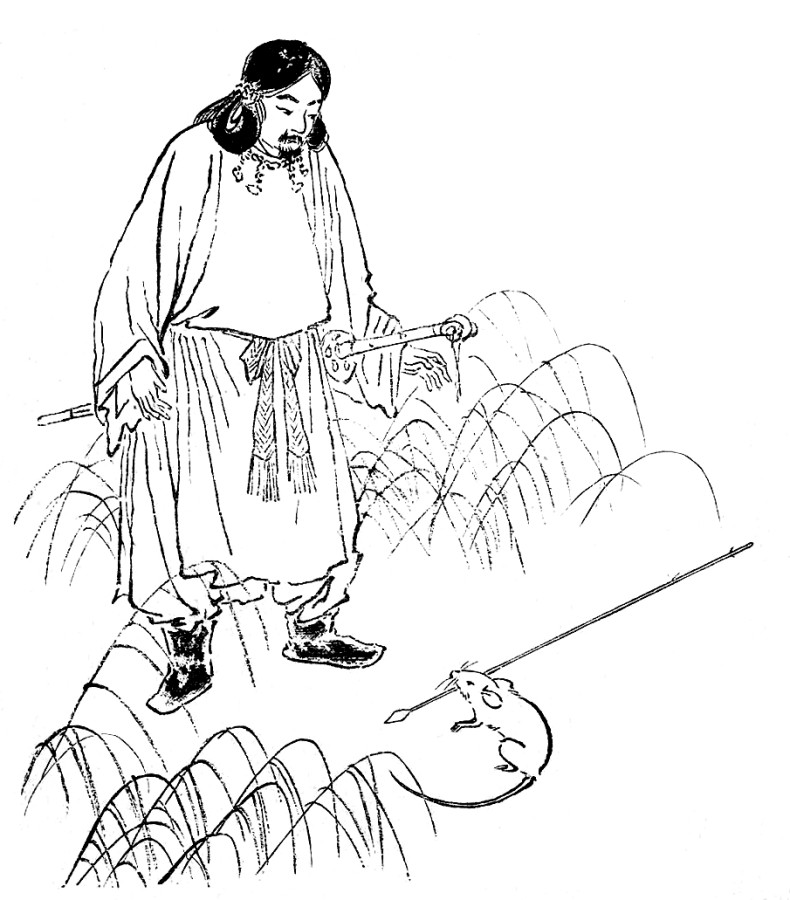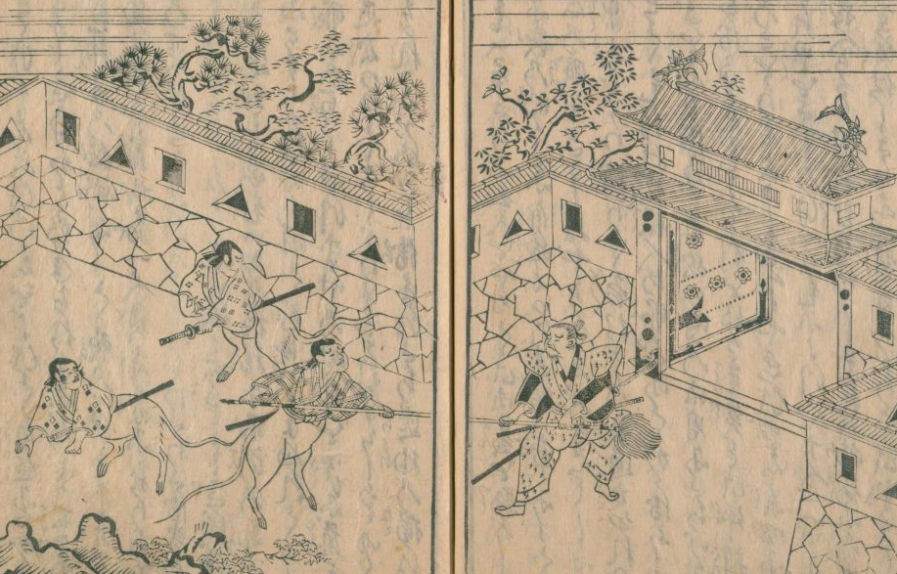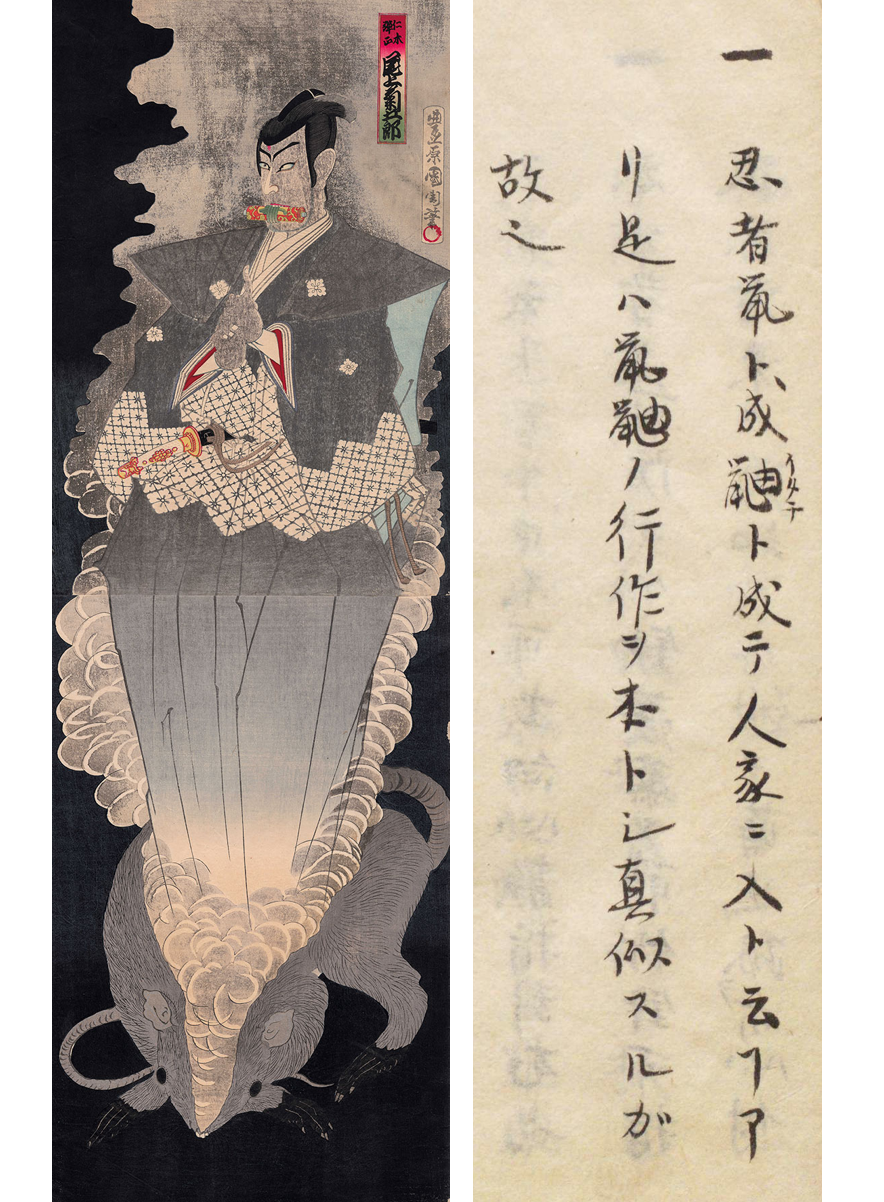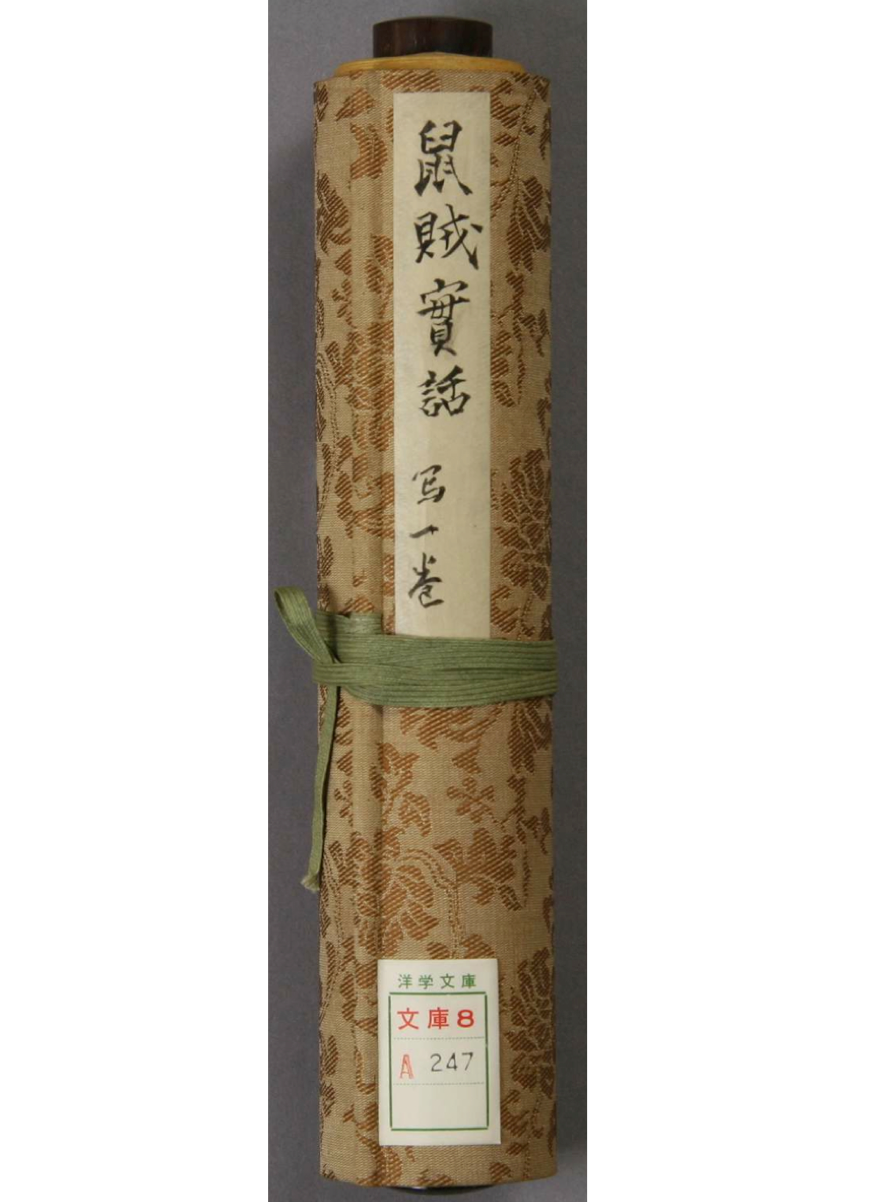
The rat, as well as being one of the animals with the best ability to adapt to the environment, is also part of Japanese mythology in many stories. One of them takes us back to a time of Shinto deities, where Susanoo (須佐之男) shot an arrow into a meadow and made Okuninushi (大国主) look for it. While looking for it, Susanoo set fire to the field and it was then that Ōkuninushi was helped by a mouse who brought him the arrow and guided him to a hole where he could protect himself from the fire. A summary of this legend was used as part of the foreword to the short staff manuscript (半棒) Kongi no Maki (摃技之巻), one of the sections of the Amatsu Tatara Hisshin Ginkōroku (天津鞴韜謐心誾琥録). Published in the chapter index of the manuscript Buhi Kanjin Kaname no Maki (武秘神心要(神眼)の巻), headed by the Togakure Ryū Happō Biken-jutsu (戸隠流八法秘剣術). Although this story of the mouse helping Ōkuninushi by showing him an escape and shelter to evade danger is reminiscent of the section "Forms of Evasion and Concealment of Rats", the Santō Tonkō no Kata (竄逃遁甲の型) of the Togakure Ryū Ninpô Tai-jutsu (戸隠流忍法体術) where the escape (竄) is formed by rat (鼠) and hole/cavity (穴) (竄=鼠+穴).

At the end of the Heian Period (平安時代) the Minamoto clan (源氏) had some internal problems before defeating the Taira clan (平氏) and ending the Genepi wars (源平合戦). Minamoto Yoritomo (源頼朝) ordered the troops of Minamoto Kurō Yoshitsune(源九郎義経) to wipe out the rebel Minamoto Kiso Yoshinaka (源木曽義仲). This was achieved at the battle of Awazu in Ōmi province (近江国粟津の戦い) where Yoshinaka who was trapped in an area of frozen mud, was hit in the head with an arrow. At the end of the Edo period (江戸時代) the legend of Yoshinaka's eldest son, Minamoto Kiso Yoshitaka (源木曽義高), known as Shimizu Kanja Yoshitaka (志水冠者義高), who tries to take revenge on Minamoto Yoritomo by resorting to the magic of rats.

Tesso (鉄鼠), later known as the vengeful spirit Raigo Nezumi (頼豪鼠), appears as a rat to Shimizu Yoshikata, who seeks to avenge the death of his father. Del Raigō Ajari Kaisoden (頼豪阿闍梨恠鼠伝)
In an interview with Hatsumi Sensei; the interviewer, Morikawa (森), makes a reference to a scene in the movie Shinobi no Mono (忍びの者) where Momochi Sandayū (百地三太夫) uses a rat and wonders if that is somehow connected to telepathy. To which Hatsumi replies that yes, it is connected to telepathy, that the ninja was able to control rats and small animals at will to carry out his missions. Something similar is done with a style of Izuna (飯綱の法) method, a shamanism practice where they used foxes so small that they were able to enter a bamboo tube, these foxes were known as Kuda-gitsune (管狐) and were said to be able to predict the future and even control people. In the Izuna and Togaksuhi area of Shinano province (信濃国), those who used this "magic" were known as Kuda-tsukai (管使い). Depending on the region the name of the magic user and the animal changed, and sometimes due to the size their description matched more with a mustelid (鼬鼠) than a small fox.
The next "logical" step would be to become a rat, something that a priori should be impossible, but it is not when folklore, legends, superstition, mythology, Yōkai ghosts (妖怪), and a long etcetera of conditioning factors come into play. The magical depictions of shinobi in Edo-period novels achieve this transformation and add to the ninja's curriculum the power of metamorphosis.

In an episode of Shinkashōki (新可笑記) several shinobi are caught running away in the middle of their rat transformation.
Although sometimes fantasy, folklore and legends can also be found in military documents such as the Gunpō Giyōshū (軍法義葉集). Among his various shinobi-related entries, one is particularly interesting in putting us on alert for the Ninja's abilities.
忍者鼠と成鼬と成て人の家に入と云事あり。是は鼠鼬の行作を本とし眞似するが故也
"It is said that the ninja (shinobi no monkey) transforms into rats and weasels to enter people's houses. This is possible because they behave like rats and weasels."

Niki Danjō (仁木弾正), starring in Noh plays as a Ninja who can transform himself into a rat at will. He could well be the shinobi of whom the Gunpō Giyōshū alerts us
The monk Kinezumi Kobōshi Kaiden (木鼠小法師怪伝), Hakushō (白勝) also known as Hakujitsuso (白日鼠), a warrior from the Suikoden (水滸伝), the kind-hearted thief Nezumi Kozō Jirōkichi (鼠小僧次郎吉), Itachi Yamatsugu (鼬山次) and Dobunezumi no Hachi (溝鼠の八)bandits of the Kumasaka Chōhan group (熊坂長範) as examples of the influence of the rat (鼠) on the names

A true tale of an sneaky thief (鼠賊実話)
June 19th 2024, Ensanryū 鳶山龍
Bibliography
天津鞴韜謐心誾琥録 摃技之巻, author, 翊翁抄
忍法大全, author 初見良昭 year 2013
武道日本, author 哲郎, year 1964
軍法義葉集
Hidden Lineage - the ninja of the Toda clan, author Sean Askew, year 2019.



